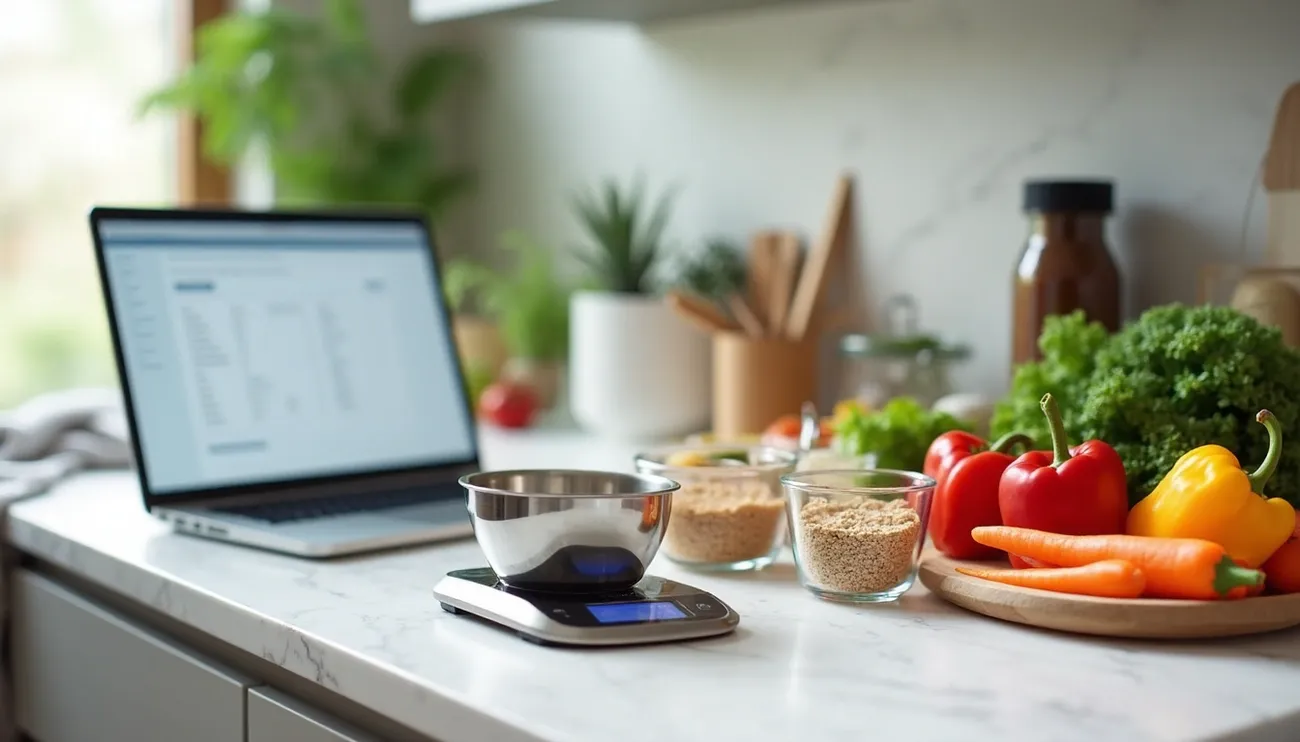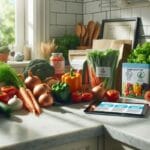How to Create a Nutrition Label in 15 Minutes: A Foolproof Guide
 Did you know that creating a nutrition label used to be a lengthy, complex process? Modern nutrition labeling software produces and customizes accurate labels that meet compliance requirements within minutes.
Did you know that creating a nutrition label used to be a lengthy, complex process? Modern nutrition labeling software produces and customizes accurate labels that meet compliance requirements within minutes.
Nutrition fact panels are mandatory for retailers with more than $50,000 in food sales and $500,000 in total sales. The FDA requires nutrition information to be available at restaurants and similar establishments that belong to chains with 20 or more locations. The FDA’s strict guidelines on font sizes and content layout can make navigating these requirements challenging.
We created this simple guide to help you create nutrition facts labels quickly. This piece will guide you through the complete process and help you develop labels for packaged foods or display nutrition information for menu items. You’ll learn everything from listing ingredients to choosing the right format that ensures FDA compliance.
What Makes Up a Nutrition Facts Label

Image Source: FDA
You need to know the components of a nutrition facts label before creating one. The FDA’s guidelines for these labels are 2016 old, marking their first major revision in over 20 years [1].
Serving size and calories
Serving size and calorie information stand out as the most visible elements on nutrition facts labels. They appear in large, bold font to boost visibility [1]. Serving sizes are standardized measurements that show what people usually eat, not what they should eat [2]. To name just one example, ice cream now shows ⅔ cup as one serving since that’s what people typically consume [3].
The “servings per container” appears below serving size and suggests how many portions the package contains [4]. Note that all nutritional values listed apply to just one serving. You’ll need to double all nutritional values if you eat two servings [5].
The label displays calories prominently so consumers can quickly see the energy content per serving [1]. While nutrition facts labels use a 2,000-calorie diet as standard, your calorie needs might vary based on your age, sex, height, weight, and activity level [5].
Macronutrients and added sugars
Labels must show total fat, saturated fat, trans fat, cholesterol, sodium, total carbohydrates, dietary fiber, total sugars, added sugars, and protein [6]. The updated label’s most important change includes “added sugars” right under total sugars [7].
This difference matters because total sugars combine both natural sugars from fruit and milk with added sugars. Research proves that too many added sugars make meeting nutrient needs harder while staying within calorie limits [5]. The daily value for added sugars is 50 grams per day on a 2,000-calorie diet [8].
The updated label removed “calories from fat” since research shows that fat type matters more than total amount [1]. All the same, saturated and trans fats still appear because a healthy diet should limit these [3].
Vitamins, minerals, and %DV
Nutrition labels must include four vital micronutrients: vitamin D, calcium, iron, and potassium [6]. These nutrients replaced vitamins A and C (now optional) because Americans don’t get enough of them [7].
The Percent Daily Value (%DV) serves as the label’s most helpful tool. It shows how each serving’s nutrients fit into your daily diet [5]. The %DV helps you spot if foods are high or low in specific nutrients:
- 5% DV or less is considered low in that nutrient
- 20% DV or more is considered high in that nutrient [9]
Creating nutrition labels becomes easier when you focus on these percentages to help consumers choose wisely. Look for foods with higher %DV in dietary fiber, vitamin D, calcium, iron, and potassium. Choose options with lower %DV in saturated fat, sodium, and added sugars [5].
A full picture of these components makes creating your own nutrition label straightforward, especially when you use a nutrition label creator tool to calculate accurate values from recipe ingredients.
How to Create a Nutrition Label from a Recipe
Let’s explore how to create a nutrition facts label now that we understand what goes into one. You need attention to detail and the right tools to create an accurate nutrition label. The process has three main steps: gathering ingredient information, analyzing nutritional content, and formatting the final label.
List all ingredients with quantities
A complete list of ingredients with precise measurements is your starting point. You’ll need to:
- Write down every ingredient in your recipe
- Measure each ingredient accurately (preferably by weight)
- Note the exact quantity of each ingredient
Precision makes a big difference here – even small measurement differences can affect your nutrition calculations. Your chocolate cake recipe might call for 2 cups of flour, 1 cup of sugar, and ½ cup of cocoa powder. List these measurements exactly as they appear.
On top of that, it helps to organize ingredients in descending order by weight. This ordering will give a clear picture to consumers about which ingredients dominate your product.
Use a nutrition label creator tool
A nutrition label creator tool comes next after your ingredient list. These online platforms make complex calculations simple. Here are some reliable options:
- ReciPal – Allows you to set up your recipe to calculate nutrition by selecting ingredients from a USDA nutrition database [10]
- VeryWell – Provides a free recipe nutrition calculator where you simply paste your ingredient list into a text box [11]
- LabelCalc – An all-in-one online nutrition labels generator that creates FDA-compliant panels [12]
These tools work in similar ways. Input your ingredients and the software calculates nutritional values automatically. Most platforms let you edit ingredients with a pencil icon or add new ones using an “+Add Ingredient” button [13].
The tool then creates a complete nutrition facts panel that shows calories, macronutrients, vitamins, and minerals based on your recipe components. Users check nutrition details from apps like the Food Scan Genius app. Download for free today and see for yourself.
Adjust for yield and portion size
Your final vital step involves adjusting for yield and portion size:
- Determine your recipe yield – the total amount of food your recipe produces [14]
- Decide on appropriate serving sizes based on FDA guidelines
- Adjust the nutrition calculations accordingly
Recipe yield means the final quantity of prepared food after following all steps. This could be weight (500g) or number of servings (24 cookies) [14].
Note that cooking processes often change food weight. Products lose weight during cooking through moisture or fat loss. This “product yield” needs consideration for your label to reflect the product’s nutritional composition accurately [15].
Your recipe might produce 10 servings but you need nutrition facts for a single serving. The tool will divide all nutrient values by 10. Most platforms have a dropdown menu labeled “Number of Servings” for these adjustments [13].
The platforms let you save your nutrition label at the end. You can generate an embed code to insert into your blog or save it for later use [13].
Choosing the Right Label Format
Making nutrition labels that work requires more than just getting the numbers right. The FDA lets manufacturers choose from several layout options based on package sizes and product types.
Standard vs. tabular vs. linear
The standard vertical format stands out as the most common nutrition label layout. It shows all required information in a vertical column. Products with plenty of labeling space use this format, which you’ll see on most store shelves.
The tabular format spreads nutrition information across the label horizontally, like a table. This layout works best when packages have enough width but limited vertical space. You’ll find the same information as the standard format, just arranged differently to use space better.
The linear format puts all nutrition information in one horizontal line without columns. This compact version helps with very small packages where space is tight. Manufacturers can shorten nutrient names to save space – “Sat. Fat” takes the place of “Saturated Fat.”
Dual-column and single-ingredient formats
Dual-column labels show nutrition facts in two side-by-side columns. These display values “per serving” next to values “per container.” The FDA requires this format for products with 2-3 servings that someone might eat at once. A pint of ice cream needs dual-column labeling because its three servings could end up as one sitting.
Pure sugar products like honey or maple syrup need their own special format. These items don’t need to list added sugar amounts in grams. They must show the percent Daily Value for added sugars with a symbol (†) that points to an explanation note.
When to use each format
Package space drives the choice of format:
- Standard vertical format: Best for labels with over 40 square inches and about 3 inches of vertical space
- Tabular format: Works well with good label space but not much vertical room
- Linear format: Fits packages under 40 square inches that can’t use vertical or tabular layouts
Your product’s size often decides the format. Some products can use simpler formats if all but one of these nutrients appear in tiny amounts.
The right nutrition label needs careful thought about both product type and package limits. Many label creation tools come with templates for all FDA-approved formats. This makes picking the right option for your needs much easier.
Ensuring FDA Compliance
The FDA strictly regulates nutrition labels. Manufacturers must follow these rules to avoid penalties. Your food products need proper labeling for legal marketing in the United States.
Follow NLEA and 2016 FDA updates
The Nutrition Labeling and Education Act (NLEA) of 1990 created the foundations for nutrition labeling. The FDA updated these requirements by a lot in 2016—the first major change in 25 years. Current scientific research and dietary guidelines shaped these updates. The changes now include “Added Sugars” declarations and remove “Calories from Fat.” They also require Vitamin D and potassium listings instead of Vitamins A and C.
The Food Allergy Safety, Treatment, Education and Research (FASTER) Act now requires sesame labeling as the ninth major allergen since January 1, 2023. Eight allergens needed declaration before: milk, eggs, fish, crustacean shellfish, tree nuts, peanuts, wheat, and soybeans.
Use correct font sizes and layout rules
The FDA has strict rules about font sizes. “Nutrition Facts” needs the largest type on standard format labels—at least 16 point. “Calories” must show up in minimum 16 point with its number in 22 point. Tabular and linear formats can use slightly smaller 10-point minimums for these elements.
Other nutrients need at least 8-point font. Footnotes can go as small as 6 point. The FDA’s formatting rules require hairlines between nutrients to touch the left border and span the label’s full width.
Include allergen and ingredient statements
The label must list ingredients by weight in descending order. Manufacturers should identify major allergens in two ways: in parentheses after the ingredient like “whey (milk)” or through a separate “Contains” statement right after the ingredient list.
A “Contains” statement must include every major allergen in the product when used. The FDA doesn’t regulate voluntary warnings like “may contain” or “produced in a facility with.” Manufacturers should create strong allergen control programs as required by the Food Safety Modernization Act.
Tips to Save Time and Avoid Mistakes
You can create accurate nutrition labels much faster with these time-saving strategies. The right approach can reduce what once took days to just 15 minutes. Your labels will still maintain compliance and accuracy.
Use preloaded ingredient databases
Preloaded ingredient databases are the life-blood of efficient nutrition label creation. Food labs have analyzed these database ingredients hundreds of times, which makes manual calculations unnecessary [16]. We used three types of databases to optimize our process:
- General ingredient databases – contain everyday items like fruits, vegetables, grains, proteins, and baking ingredients
- Branded ingredient databases – include pre-made components from specific manufacturers
- Custom ingredient/subrecipe databases – store your frequently used ingredient combinations [16]
The USDA database forms the foundation for many nutrition calculator systems and provides reliable nutrient information that experts have verified extensively. This eliminates the need to get pricey lab testing while maintaining accuracy [16].
Clarify ambiguous ingredients
Ambiguous or specialty ingredients cause the biggest delays in creating nutrition labels. You should get ingredient specification sheets from suppliers for any items not found in standard databases before starting your calculations [17].
Note that nutrition data from calorie counting websites or existing food labels isn’t ideal. This information might be incorrect or already rounded, which reduces accuracy in your analysis [17]. You should always ask for unrounded data for a 100-gram sample from your ingredient suppliers.
Your results will be more consistent and precise if you measure ingredients by weight instead of volume [17].
Preview before finalizing
The final step—people often skip this—is to preview your nutrition label really well before publication. You should double-check all calculations and cross-reference ingredient nutritional data. This prevents compliance issues and customer mistrust [18]. Users check nutrition details from apps like the Food Scan Genius app. Download for free today and see for yourself.
Common labeling mistakes to avoid include:
- Inaccurate nutritional calculations
- Ambiguous serving sizes
- Missing allergen warnings
- Poor legibility that violates FDA standards [18]
Of course, documenting your calculation process is a vital part not only for accuracy but also for potential FDA verification requests [19]. By doing this and being systematic, you’ll create professional, compliant nutrition labels in minutes rather than hours.
Conclusion
You don’t need weeks of work or expensive lab testing to create accurate nutrition labels anymore. In this piece, we’ve covered everything in nutrition facts labels, from step-by-step creation to format options and compliance requirements.
Nutrition labeling isn’t just a legal requirement – it’s a valuable service for your customers. The FDA guidelines might look overwhelming at first, but modern tools have made this process much simpler.
Note that accuracy matters by a lot when you create your labels. Wrong measurements or missing ingredients can cause compliance problems and hurt consumer trust. Always check your ingredients list twice, confirm proper serving sizes, and verify all calculations before you finalize your nutrition facts panel.
On top of that, it helps to pick the right format based on your packaging needs to present information clearly while staying compliant. The standard vertical format works best for most products. Tabular and linear options work well for specific packaging limits.
Creating nutrition labels shouldn’t stress you out or leave you confused. With the right tools and a good grasp of FDA requirements, you can make professional, compliant nutrition labels quickly.
The process comes down to three basic steps: list ingredients accurately, use reliable nutrition calculation tools, and format everything properly. These steps will help you turn a challenging task into a simple 15-minute job.
Food manufacturers today have better access to technology that makes compliance easier. This helps both producers and consumers, making sure nutritional information reaches the people who need it most.
FAQs
Q1. How long does it typically take to create a nutrition label?
With the right tools and information, you can create an accurate nutrition label in about 15 minutes. Modern nutrition label creator tools have significantly streamlined the process that once took days or even weeks.
Q2. What are the key components of a nutrition facts label?
A nutrition facts label must include serving size, calories, macronutrients (fats, carbohydrates, protein), micronutrients (vitamins and minerals), and percent daily values. It should also list added sugars and allergens.
Q3. Do I need to conduct laboratory tests to create a nutrition label?
No, laboratory tests are not always necessary. You can use preloaded ingredient databases and nutrition label creator tools to calculate accurate nutritional information for your product based on its recipe.
Q4. How do I choose the right format for my nutrition label?
The format choice depends on your packaging size and available space. Use the standard vertical format for larger packages, tabular format for limited vertical space, and linear format for very small packages with less than 40 square inches of labeling space.
Q5. What are some common mistakes to avoid when creating nutrition labels?
Common mistakes include inaccurate nutritional calculations, ambiguous serving sizes, missing allergen warnings, and poor legibility that violates FDA standards. Always double-check your calculations, clarify ingredient information, and preview the label before finalizing.
References
[1] – https://www.fda.gov/food/nutrition-facts-label/whats-nutrition-facts-label
[2] – https://www.fda.gov/food/nutrition-facts-label/serving-size-nutrition-facts-label
[3] – https://www.cdc.gov/healthy-weight-growth/healthy-eating/nutrition-label.html
[4] – https://www.heart.org/en/healthy-living/healthy-eating/eat-smart/nutrition-basics/understanding-food-nutrition-labels
[5] – https://www.fda.gov/food/nutrition-facts-label/how-understand-and-use-nutrition-facts-label
[6] – https://medlineplus.gov/ency/article/002459.htm
[7] – https://nutritionsource.hsph.harvard.edu/food-label-guide/
[8] – https://www.fda.gov/food/nutrition-facts-label/added-sugars-nutrition-facts-label
[9] – https://www.mymlc.com/health-information/faqs/p/percent-daily-value-what-does-it-mean/
[10] – https://www.recipal.com/
[11] – https://oneingredientchef.com/how-to-get-nutrition-facts/
[12] – https://labelcalc.com/
[13] – https://www.verywellfit.com/recipe-nutrition-analyzer-4157076
[14] – https://foodlabelmaker.com/faq/what-does-recipe-yield-mean-and-when-should-i-manually-edit-it/
[15] – https://blog.trustwell.com/yield-adjustments-in-genesis-rd-foods-moisture-loss-fat-loss-and-processing-loss
[16] – https://labelcalc.com/using-labelcalc-understanding-ingredient-databases/
[17] – https://www.foodbevy.com/a-handy-guide-to-nutrition-labeling/
[18] – https://www.sheetlabels.com/blog/how-to-create-nutrition-fact-labels-for-homemade-food-products?srsltid=AfmBOoq0DbeoDccFuXV0Abs36OXBF5oHS67tOqFcJjUhc7eR9WKwwjVL
[19] – https://blog.trustwell.com/using-nutrition-database-recipe-analysis





